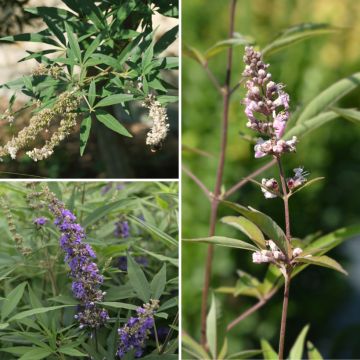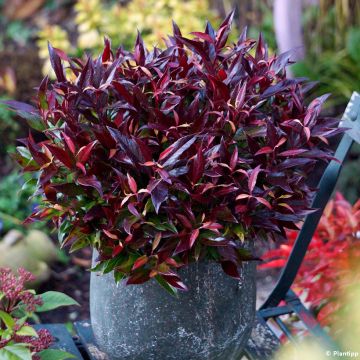

Cestrum elegans (purpureum) Rubrum
Cestrum elegans Rubrum
Cestrum elegans Rubrum
Purple Cestrum, Bastard Jasmine
Due to negligence, he spent the winter outside (Puget-sur-Durance). He has managed quite well, currently blooming, but with few leaves. Naturally, next winter, he will receive better care.
nicole, 15/05/2022
Special offer!
Receive a €20 voucher for any order over €90 (excluding delivery costs, credit notes, and plastic-free options)!
1- Add your favorite plants to your cart.
2- Once you have reached €90, confirm your order (you can even choose the delivery date!).
3- As soon as your order is shipped, you will receive an email containing your voucher code, valid for 3 months (90 days).
Your voucher is unique and can only be used once, for any order with a minimum value of €20, excluding delivery costs.
Can be combined with other current offers, non-divisible and non-refundable.
Why not try an alternative variety in stock?
View all →This plant carries a 24 months recovery warranty
More information
We guarantee the quality of our plants for a full growing cycle, and will replace at our expense any plant that fails to recover under normal climatic and planting conditions.
Would this plant suit my garden?
Set up your Plantfit profile →
Description
Cestrum elegans (purpureum) 'Rubrum' is a selection of purple cestrum that charms with its clusters of small tubular flowers in a deep pink-red colour. This richly coloured flowering is very long, from late spring to the end of summer, and is well highlighted by its long dark green leaves, as well as its red fruiting which is attractive. With a flexible, elegant, and colourful habit, this bush has a certain charm. But its sensitivity to frost requires it to be grown most often in a pot, to be able to shelter it in winter. In southern gardens spared by heavy frosts, it can be planted in the ground with winter protection.
Cestrum elegans 'Rubrum' belongs to the Solanaceae family, just like Solanums and tomatoes. It is a shrub native to Mexico, whose foliage theoretically persists in winter. The above-ground vegetation is destroyed below 0°C (32 °F), but the stump is capable of regrowth after a brief freeze of around -5°C (23 °F). The plant has a flexible and slightly open habit, supported by slightly arched stems. With rapid growth, the purple cestrum reaches about 3m (9ft 10in) in height and 1.20m (3ft 11in) in spread in the ground, but retains more modest dimensions in a pot. The alternate arranged leaves are simple, narrow, lanceolate, glabrous, and a matte dark green on the upper side, lighter and downy underneath. Flowering generally begins in June, earlier or later depending on the climate and growing conditions. It will continue until the end of September or early October if faded flowers are removed. The flowers are gathered in slightly trailing terminal clusters of dark red-pink colour, measuring about 10cm (3.9in) long. Each flower has the shape of a small tube that opens into a star at its end. After pollination, small round berries form and turn red when ripe.
Cestrum 'Rubrum' is capable of flowering almost all year round if the plant is protected from frost in winter in a very bright conservatory, making it an excellent orangery plant. In addition to its ornamental qualities, it is a low-demanding shrub in terms of soil, as long as it is fertile and not too dry. In a garden on the Mediterranean or south Atlantic coast, this beautiful plant will go well with the Cape Leadwort, Tarentina Myrtle, oleander or an Indian Lilac, for example.
Report an error about the product description
Cestrum elegans Rubrum in pictures




Plant habit
Flowering
Foliage
Botanical data
Cestrum
elegans
Rubrum
Solanaceae
Purple Cestrum, Bastard Jasmine
Central America
Other Shrubs A to Z
View all →Planting and care
Cestrum elegans 'Rubrum' is preferably planted in spring, in sunny or semi-shaded areas. It adapts to any ordinary but well-drained, moist, fertile, and organic-rich soil. Once established, the bush can withstand temporary droughts, but it is preferable to water it regularly in summer to promote growth and flowering. Cestrums do not suffer from any specific disease or parasite. However, it is necessary to monitor the appearance of red spiders and whiteflies on plants grown indoors or in greenhouses. The above-ground vegetation is destroyed as soon as it freezes, at 0°C. But the stump can regenerate in spring after a short frost of around -5°C. Well-protected under a thick mulch, this stump can sometimes show even greater hardiness, but in rather dry soil during winter.
Planting period
Intended location
Care
-
, onOrder confirmed
Reply from on Promesse de fleurs
Haven't found what you were looking for?
Hardiness is the lowest winter temperature a plant can endure without suffering serious damage or even dying. However, hardiness is affected by location (a sheltered area, such as a patio), protection (winter cover) and soil type (hardiness is improved by well-drained soil).

Photo Sharing Terms & Conditions
In order to encourage gardeners to interact and share their experiences, Promesse de fleurs offers various media enabling content to be uploaded onto its Site - in particular via the ‘Photo sharing’ module.
The User agrees to refrain from:
- Posting any content that is illegal, prejudicial, insulting, racist, inciteful to hatred, revisionist, contrary to public decency, that infringes on privacy or on the privacy rights of third parties, in particular the publicity rights of persons and goods, intellectual property rights, or the right to privacy.
- Submitting content on behalf of a third party;
- Impersonate the identity of a third party and/or publish any personal information about a third party;
In general, the User undertakes to refrain from any unethical behaviour.
All Content (in particular text, comments, files, images, photos, videos, creative works, etc.), which may be subject to property or intellectual property rights, image or other private rights, shall remain the property of the User, subject to the limited rights granted by the terms of the licence granted by Promesse de fleurs as stated below. Users are at liberty to publish or not to publish such Content on the Site, notably via the ‘Photo Sharing’ facility, and accept that this Content shall be made public and freely accessible, notably on the Internet.
Users further acknowledge, undertake to have ,and guarantee that they hold all necessary rights and permissions to publish such material on the Site, in particular with regard to the legislation in force pertaining to any privacy, property, intellectual property, image, or contractual rights, or rights of any other nature. By publishing such Content on the Site, Users acknowledge accepting full liability as publishers of the Content within the meaning of the law, and grant Promesse de fleurs, free of charge, an inclusive, worldwide licence for the said Content for the entire duration of its publication, including all reproduction, representation, up/downloading, displaying, performing, transmission, and storage rights.
Users also grant permission for their name to be linked to the Content and accept that this link may not always be made available.
By engaging in posting material, Users consent to their Content becoming automatically accessible on the Internet, in particular on other sites and/or blogs and/or web pages of the Promesse de fleurs site, including in particular social pages and the Promesse de fleurs catalogue.
Users may secure the removal of entrusted content free of charge by issuing a simple request via our contact form.
The flowering period indicated on our website applies to countries and regions located in USDA zone 8 (France, the United Kingdom, Ireland, the Netherlands, etc.)
It will vary according to where you live:
- In zones 9 to 10 (Italy, Spain, Greece, etc.), flowering will occur about 2 to 4 weeks earlier.
- In zones 6 to 7 (Germany, Poland, Slovenia, and lower mountainous regions), flowering will be delayed by 2 to 3 weeks.
- In zone 5 (Central Europe, Scandinavia), blooming will be delayed by 3 to 5 weeks.
In temperate climates, pruning of spring-flowering shrubs (forsythia, spireas, etc.) should be done just after flowering.
Pruning of summer-flowering shrubs (Indian Lilac, Perovskia, etc.) can be done in winter or spring.
In cold regions as well as with frost-sensitive plants, avoid pruning too early when severe frosts may still occur.
The planting period indicated on our website applies to countries and regions located in USDA zone 8 (France, United Kingdom, Ireland, Netherlands).
It will vary according to where you live:
- In Mediterranean zones (Marseille, Madrid, Milan, etc.), autumn and winter are the best planting periods.
- In continental zones (Strasbourg, Munich, Vienna, etc.), delay planting by 2 to 3 weeks in spring and bring it forward by 2 to 4 weeks in autumn.
- In mountainous regions (the Alps, Pyrenees, Carpathians, etc.), it is best to plant in late spring (May-June) or late summer (August-September).
The harvesting period indicated on our website applies to countries and regions in USDA zone 8 (France, England, Ireland, the Netherlands).
In colder areas (Scandinavia, Poland, Austria...) fruit and vegetable harvests are likely to be delayed by 3-4 weeks.
In warmer areas (Italy, Spain, Greece, etc.), harvesting will probably take place earlier, depending on weather conditions.
The sowing periods indicated on our website apply to countries and regions within USDA Zone 8 (France, UK, Ireland, Netherlands).
In colder areas (Scandinavia, Poland, Austria...), delay any outdoor sowing by 3-4 weeks, or sow under glass.
In warmer climes (Italy, Spain, Greece, etc.), bring outdoor sowing forward by a few weeks.




















































